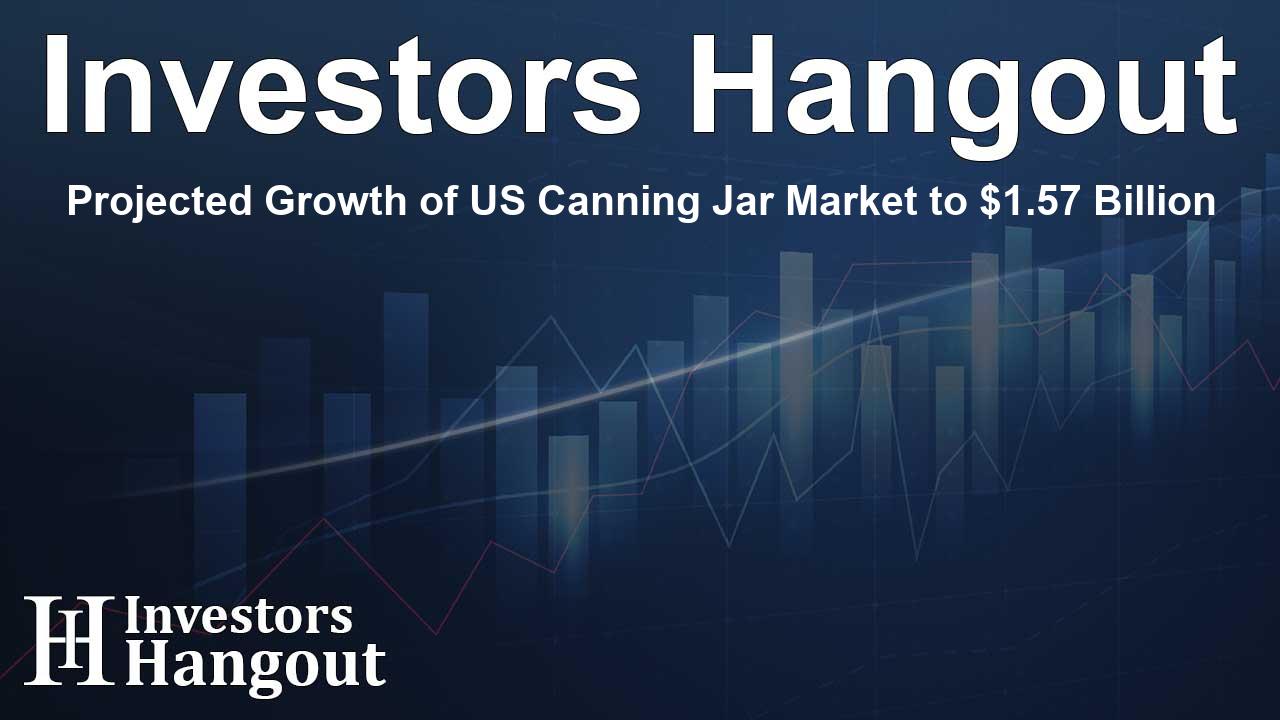Projected Growth of US Canning Jar Market to $1.57 Billion

Prospective Growth in the US Canning Jar Market
The US canning jar market is anticipated to experience significant growth over the upcoming years. In 2024, the market valuation stood at approximately $923.56 million. It is projected to swell to around $1,573.56 million by 2033, with a robust compound annual growth rate (CAGR) of 6.26% expected during the period spanning from 2025 to 2033.
Glass vs. Plastic: The Material Showdown
Traditionally, glass jars have dominated the US canning market, capturing an impressive 84% of total unit sales in 2024. Particularly, wide-mouth quart jars accounted for 56% of home-preservation purchases, reflecting a strong preference among consumers for glass, especially among established canners who value flavor retention and eco-friendliness.
Conversely, there has been a noticeable uptick in the adoption of plastic jars, especially those made of PET and clarified polypropylene, which recorded a 9% growth in shipments since 2021. Their lightweight nature and enhanced durability have made them appealing for on-the-go and food-service applications. Interestingly, platforms like Amazon showed that glass quart jars occupied 68% of the top 100 best-selling jar listings in early 2024, while independent hardware stores increasingly stock Ball wide-mouth products year-round.
Changing Preferences in Canning Practices
As preferences evolve, recent surveys highlight a closer competition between glass and plastic jars in the condiment sector. Findings from Freedonia indicated that 31% of commercial brands tested plastic jars, a noticeable increase from only 22% in 2021. Sustainability initiatives also propelled glass innovation forward, with the vast majority of Ball's canning catalog featuring recycled-content glass, enhancing its market appeal.
Emerging Trends in the Canning Jar Sector
Innovation is at the forefront of the US canning jar market. Recent statistics show that 23% of new jar launches utilized at least 50% recycled materials, indicating a shift towards genuine sustainability. Noteworthy advancements in jar design, such as Libbey’s new light-weight glass that reduces empty-jar weight while maintaining structural integrity, further emphasize this trend.
Smart Connectivity Revolutionizes Consumer Interaction
Moreover, jars with intelligent lids incorporating NFC technology have surged by 41% year-over-year, underlining a consumer shift towards interactive products that enhance user experience with features like freshness indication and recipe access. These trends are reshaping how consumers interact with their food preservation methods.
Utilization Beyond Traditional Preservation
Although home food preservation remains the core function, the usage of canning jars is rapidly diversifying. Surges in interest for jar salads and cafes utilizing jars for beverage presentations highlight this versatility. It reflects a growing culture where jars are integrated into lifestyle choices beyond food preservation.
Commercial usage is also expanding, with many stores utilizing jars for bulk non-packaged items, tapping into the sustainable shopping trend. Approximately 33% of package-free grocery stores have adopted jars for dry goods, reflecting new industrial reuse models gaining traction.
Consumer Behavior and Market Dynamics
Consumer behavior continues to drive the canning jar market forward. According to recent surveys, nearly half of US households participated in some canning activity, driven largely by transparency over contents and ingredient sourcing. Additionally, a notable 62% of novice canners cited ingredient clarity as a crucial factor influencing their involvement.
This robust interest has been mirrored by increased purchasing behavior, particularly among higher-income households, evidencing a shift in demographics and a potential growth area for manufacturers focusing on this segment.
Understanding Regional Market Opportunities
The regional dynamics shaping the US canning jar market unveil interesting opportunities. States like California, with its environmentally focused legislation, contribute significantly to online jar sales, while Texas showcases growth in local canning ventures. Traditional markets in the Southeast are experiencing revitalized interest, with increased participation in canning classes reflecting a cultural resurgence.
The Competitive Landscape
The US canning jar market is characterized by a blend of legacy and innovative players. Companies like Ball Corporation and Newell Brands lead the market, commanding a substantial share due to their established reputations. Meanwhile, new entrants and start-ups are diversifying product offerings, enhancing competition.
Investment in capacity and sustainability initiatives is paramount, as seen in Libbey Glass's recent enhancements at its facilities, which aim to increase output and maintain competitive advantages. Additionally, partnerships between firms and e-commerce platforms are transforming how products reach consumers, capitalizing on the shifting landscape of retail.
Frequently Asked Questions
What is the projected value of the US canning jar market by 2033?
The US canning jar market is expected to grow to approximately $1.57 billion by 2033.
Which material currently holds the largest market share in canning?
Glass jars dominate the market, accounting for about 84% of annual unit sales.
How are consumer preferences impacting the market?
There is a noticeable shift toward sustainable practices and products, prompting changes in brand offerings and materials used.
What innovations are shaping the future of canning jars?
Recent trends include the introduction of smart lids and the increased use of recycled materials in production.
Which sectors are increasing demand for canning jars?
Multiple sectors, including food service and artisanal producers, are expanding the demand for canning jars beyond traditional home preservation.
About The Author
Contact Thomas Cooper privately here. Or send an email with ATTN: Thomas Cooper as the subject to contact@investorshangout.com.
About Investors Hangout
Investors Hangout is a leading online stock forum for financial discussion and learning, offering a wide range of free tools and resources. It draws in traders of all levels, who exchange market knowledge, investigate trading tactics, and keep an eye on industry developments in real time. Featuring financial articles, stock message boards, quotes, charts, company profiles, and live news updates. Through cooperative learning and a wealth of informational resources, it helps users from novices creating their first portfolios to experts honing their techniques. Join Investors Hangout today: https://investorshangout.com/
The content of this article is based on factual, publicly available information and does not represent legal, financial, or investment advice. Investors Hangout does not offer financial advice, and the author is not a licensed financial advisor. Consult a qualified advisor before making any financial or investment decisions based on this article. This article should not be considered advice to purchase, sell, or hold any securities or other investments. If any of the material provided here is inaccurate, please contact us for corrections.
